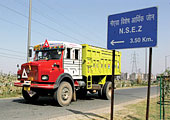 |
| Mahindra World City: Singapore's Ascendas
is developing one million sq. ft of business space at the
Mahindra SEZ in Chennai. The IT Park will cover 18.5 acres
of land. The investment is expected to be around Rs 50 crore |
Circa
2015: John Doe Jr., the young new CEO at one of the world's largest
auto-parts companies, is on a guided tour of Reliance's Maha Mumbai
special economic zone (SEZ). Doe wants to invest more than a billion
dollars in a new factory, and he's weighing his options, which
include India and China. His father, John Doe Sr., who last visited
India in 2008, has warned him against investing in India because,
as he remembers, it has a horrendous bureaucracy, convoluted regulations,
and pathetic infrastructure. Yet, the young man has decided to
check out Reliance's new SEZ because he's heard a lot of good
things about it from some of his peers who already operate out
of the SEZ.
As the Reliance chopper in which he's seated
gives him an aerial view of the city, Doe Jr. can hardly believe
what he sees. Forget China's Shenzhen; this city is something
else. Beautifully laid out roads, clearly zoned residential and
industrial areas look stunning from about 2,500 feet above ground.
The numbers, which Reliance's head of SEZ offers to Doe Jr., are
even more impressive. Almost a fifth of Fortune 500's manufacturing
companies already have facilities in the SEZ, with investments
of about $5 billion; the SEZ airport, world-class in every respect,
can handle 90 million passengers a year (as much as Frankfurt
airport) and 4 million tonnes of cargo. As a new city, Maha Mumbai
has brought down real estate prices in the main Mumbai city and
eased pressure on infrastructure. As an economic zone, it accounts
for 5 per cent of India's total exports of $1 trillion. There's
no red tape, there are no power cuts or water problems. What's
more, there's a booming, vibrant city of blue and white-collar
workers, whose per capita income is three times the national average.
"Gosh, dad couldn't have been more wrong," thinks Doe
Jr. "India it has to be."
 |
| Mundra SEZ: The Adani Group-promoted
SEZ, spread over 100 sq. km, offers a port that has the deepest
draught on the western coast |
As things stand today, no one knows the following:
a) Will Reliance's, or any other SEZ investor's, dream of creating
world-class urban centres in India ever come true? b) Will some
investor, some day, go back as impressed with India's infrastructure
and bureaucracy as John Doe Jr? c) Will India's exports actually
hit a trillion dollars by 2015? d) Will prosperity trickle down
to the poorer Indians as visibly as in the crystal-gazing above?
e) Will India ever give China a run for its money?
If no one really knows, it's because the
great circus that the issue of SEZs has been turned into. Farmers
would rather continue living at subsistence levels than sell their
land; industry wants to squeeze the maximum out of a well-intentioned
plan, thereby endangering its very feasibility, and the government
would rather ensure its own survival by washing its hands off
a politically explosive issue than screw up courage to come up
with a pragmatic policy that works in the interest of all stakeholders.
Thus, a cap on SEZs, both in terms of their number and size, is
thought of, and farmers are left to deal with developers directly
and vice versa. With the result, a good idea runs the risk of
being still-born.
| SEZs BY THE NUMBERS |
| No. of functional SEZs |
19 |
| No. of valid formal approvals
(with land) |
234 |
| No. of notified out of 234 SEZs |
63 |
| No. of formal approvals cleared
for notification |
83 |
| No of in-principle approvals
(without land) |
162 |
| Pending proposals |
370 |
| Investment made in 63 notified
SEZs |
Rs
13,435 crore |
| Employment created in 63 notified
SEZs |
18,457
persons |
| Estimated investment if 234
formal approvals become operational |
Rs
3,00,000 crore |
| Employment |
4
million jobs |
| Source: Commerce Ministry |
The need of the hour is to ask some important
questions about the SEZs and find the right answers. Here, we
make an attempt:
Q. Do we need so many SEZs or can we simply
follow the China model?
This is a question that has been doing the
rounds ever since the policy was first conceived in 2005. The
question emanates from the tremendous success of the Chinese model.
In eight years from 1980 to 1988, China established the SEZs in
Shenzhen, Zhuhai, Shantou and Xiamen cities, and Hainan province.
And by 2002, these free trade zones had attracted $60 billion
of investments, employed two million people and were contributing
15-23 per cent to the nation's exports, according to a KPMG report.
Surely this success is worth emulating. However, the Chinese SEZs
are few in number and large in size. The famed-Shenzen, at best
a mid-sized zone, is 327 square kilometers. The Hainan island
is 34,000 square kilometers. Indian SEZs, with their cap on size
at 5,000 hectares (50 sq km), are going to be midgets in comparison.
Even Reliance with its proposed 10,000 hectare SEZs would have
been middling at best in terms of sheer size. Fewer, larger SEZs
have a compelling economic logic with their scale, and ease of
administration. Anita Arjan Dass, Managing Director of Mahindra
City, points out that a large size is preferred by a developer
since it prevents overexposure to just one industry (as in single-industry
SEZ) and protects investments. "Besides, the growth of ancillary
industry development for a multi-product SEZ could be stymied
in a small-sized SEZ. Today, large companies want to bring their
ancillaries with them," Dass says.
SEZs VS THE REST
Compared to other sweet schemes, SEZs
offer an opportunity to build an island of world-class facilities.
|
SEZs
Units*
» Complete
exemption from corporate tax for the first five years; 50
per cent exemption for next five years and a 50 per cent
exemption for a further five years equivalent to the special
reserves created by the units
» Complete
exemption from Minimum Alternate Tax (MAT).
» Complete
exemption from import duties. On procurement from the domestic
tariff area do not have to pay excise, VAT, or (central
sales tax) CST. Service tax is also exempt on services consumed
within the zone
Developers
» 10-year
tax holiday on profits derived from development of SEZs.
» Complete
exemption from MAT, Dividend Distribution Tax
EOUs (March 31, 2009)
Direct Tax
» 100
per cent tax deduction on export profits
Indirect Tax
»
Nil import duty
» Nil
excise duty on procurement of goods from bonded warehouses
in the domestic tariff area (DTA)
» Reimbursement
of CST paid on purchases from DTA
EHTP/ STPI (Direct tax deduction till March 31, 2009)
Direct Tax
» Deduction
of 100% export profits derived therefrom for any 10 consecutive
years Indirect Tax
Nil import duty
»
Nil excise duty on procurement of goods from bonded warehouses
in the DTA
» Reimbursement
of CST paid on purchases from DTA
Industrial Parks (Available to developers notified
by DIPP on or before March 31, 2009)
Developers
» 100
per cent tax deduction is available to the developers of
industrial parks for any 10 consecutive assessment years
out of 15 years
Units
» Income
tax holiday and exception from CENVAT is available for units
set up in industrial parks in the states of Uttarakhand,
Himachal Pradesh, Sikkim and Northeast, subject to certain
conditions
* Exemptions available only to physical
export profits, EOUs: Export-Oriented Units, EHTP: Electronics
Hardware Technology Parks, STPI: Software Technology Parks
of India,
Source: Commerce Ministry, PwC & BT Research
|
However, can the China model be supplanted
directly? No. For one, India is a democracy and free market economy.
Government diktats cannot, and should not, determine economic
progress. Two, skill sets vary in different regions of the country,
says G.R.K. Reddy, Managing Director, Marg Constructions, which
is developing over 600 acres in two adjacent locations. "Population
density and per capita income also vary from region to region-so
the one-size-fits-all strategy won't work. More numbers of SEZs
would have to be scattered around as transporting people would
be difficult," he adds. However, do we need a cap on the
number? No. It's for the market to determine how many SEZs it
can profitably accommodate. By restricting the number of SEZs,
we will be making the same mistakes that we made by restricting
manufacturing capacities and licensing industries.
 |
| Noida SEZ: Formerly an export processing
zone, it covers 125 ha and is home to 141 active units |
Q. Should there be a minimum limit on the
"processing area"?
The hike in processing area (where core activity,
manufacturing or otherwise, would take place) to a uniform 50
per cent of the total area has reduced the real estate play somewhat.
SEZs cannot now be used as a surrogate for urban development.
Srikanth Badiga, VP, Hyderabad Gems SEZ, says, "The processing
area is in a sense a surrogate for industrialisation. The norm
for 50 per cent processing zone is crucial to ensure that players
serious about industrialisation get in and not those who are only
interested in real estate development."
However, this rule also trims the returns
expected by the SEZ developer considerably. "With the current
norms, the returns for SEZ players have come down by 15-20 per
cent, mainly due to the increase in processing area. The per-square
feet realisation tends to be lower in the processing area,"
says Unitech Managing Director, Sanjay Chandra, while adding that
much would depend on the location of the SEZ. Unitech is a joint
venture partner with the Salim Group and Universal Success Group
at the proposed SEZ at Nandigram and surrounding areas. So, should
there be a minimum limit? Yes. And does the 50 per cent limit
still leave enough on the table for developers? Yes, again.
 |
 |
| Commerce
Minister Kamal Nath has been championing the cause
of SEZs, but has had to make concessions to accommodate interests
of Left front allies that want SEZs curtailed |
Reliance
Industries' Mukesh Ambani has plans of setting up two
mega SEZs of 10,000 ha each, but the cap of 5,000 ha could
force him to curtail his SEZ ambitions |
Q. Should there be a maximum limit to the
size of SEZs, like the 5,000 ha cap set by the government?
No. It just doesn't make any sense. Just
as no automobile manufacturer makes 200-ft-long cars, no developer
will make an SEZ bigger than what he can profitably sell. Remember,
there's cost to every sq. ft of land developed. Yet, flexibility
in terms of size is important to create a competitive and efficient
economic region. "Certain infrastructure costs like cargo
handling, power costs, port development would make sense only
if the SEZ is really large in size," says Mahindra City's
Dass, adding that her firm is comfortable with the current size
of 1,300 acres, because "we feel that this is the size that
we can optimally manage."
However, should the developer have an appetite
for larger areas, there is no economic or financial rationale
for the cap of 5,000 hectares. The sole reason this ceiling seems
to have been incorporated is to cater to the demands of the intransigent
government allies, notably the Left Front, which was caught on
the back foot in its own back yard when violent protests in Nandigram
broke out. Does it create problems? Not really. There were just
a handful of SEZs that were larger than this cap. But, as Mukesh
Khandelwal of infrastructure consulting firm, Feedback Ventures,
says, "5,000 hectares is still a fair amount of land for
SEZ development." Finally, if any developer wants to go round
the cap, he'll find ways to do it.
 |
 |
DLF's
Rajiv Singh
has plans of setting up an 8,097 hectare multi-product SEZ
in Gurgaon, but,
like Reliance, may have to make do
with an SEZ half that size. |
Videocon
Industries' Venugopal Dhoot says that the state must
play at least a limited role in land acquisition, otherwise
the going will be difficult for the SEZ developers. |
Q. Should the government help with land
acquisition?
No. Let the farmers decide if they want to
sell their land and at what price. Forcible acquisition of land,
which is what the government's 'eminent domain' right ensures,
will always be resisted, and rightly so. But will the government's
non-involvement make land acquisition more difficult? Yes, it
will. But that's a good entry barrier to SEZs, and something that
will automatically prevent oversupply of SEZs into the market.
However, the government may still have a limited role to play.
Videocon Group Chairman, Venugopal Dhoot, who currently heads
business chamber, assocham, says there are practical issues in
private land acquisition, as some states have land ceiling acts
on transfer of land into private hands. "The state governments
should be involved at least in things like acquisition notices.
The private developers can take charge of the financial transactions."
N.D. Mehra, Head Commercial & Legal,
DS Constructions, believes that without government intervention
the stipulation of contiguity of land-one of the requirements
of the multi-product SEZs-would be affected. Contiguity is a mandatory
requirement of the SEZ regulations and is critical for success.
"For an SEZ to be successful it must be self-sustaining,
containing all the requisite infrastructure, utilities, facilities
and services."
 |
| Reliance Haryana SEZ: Originally, Reliance
was to buy most of the land here on its own |
At any rate, the combination of a cap on the
maximum size of the SEZ and the government withdrawal from land
acquisition is quite unsustainable. "If the government is
not going to help in land acquisition then capping the maximum
size does not have any logic," points out Mehra of DS Constructions.
The government, especially the Prime Minister's
Office, seems to be veering around to the view that some government
aid is in order especially if the private developer acquires,
say, 75-80 per cent of the land required. That seems to be a reasonable
demand, since private purchase would have already 'discovered'
a market price for the land that the government can order the
'problematic' landowner to accept.
Q. Will there be a revenue loss to the
exchequer on account of special economic zones?
This is a chicken-and-egg question. Sure,
the revenues foregone on business that would come up in SEZs would
be a loss. However, the question that follows then is-in the absence
of the SEZ policy would that business set up shop in India at
all? The finance ministry did put forth its apprehensions of a
revenue loss, yet the considered view of the government was that
the advantages accruing from the SEZs would far outweigh any possible
revenue loss on their account.
With regard to existing businesses moving
into SEZs, there are enough safeguards to ensure that domestic
market-oriented companies find it prohibitively expensive to sell
to the domestic tariff area after producing the goods in the SEZ.
In most cases, imports would be cheaper. So these apprehensions
are mostly misplaced.
HURT BY THE CEILING
Developers may still work around the ceiling
problem, but these are the ones that will be the most affected.
|
| Reliance's Maha Mumbai project |
10,000
hectare |
| Reliance's Jhajjar (Haryana)
SEZ |
10,000
hectare |
| DLF's multi-product SEZ in Gurgaon |
8,097
hectare |
| Omaxe project in Rajasthan |
6,070
hectare |
| Bharat Forge, Pune |
7,000
hectare |
Where they could have some credibility is
in case of SEZs that are oriented towards it and it-enabled services.
Many of them are planning to shift incremental business to SEZs
due to the expiry of sops under STPIS and others. However, here
too it is the overall operating business environment that makes
SEZs attractive. For instance, for business process outsourcing
companies, 40 per cent of the advantage of working in India comes
from cost alone. If the overall operating cost in India gets mitigated
by moving to an SEZ, then that is hardly bad news. As Rohit Kapoor,
CFO, EXL Services, says, "Business policies are making operating
in India quite expensive. Destinations such as Vietnam, the Philippines,
South Africa and East European countries are becoming increasingly
attractive." An it SEZ, then, will make India more attractive
compared to rival countries.
Q. Are SEZ developers fighting shy of
resettlement and rehabilitation expenses?
Not really. India Inc. in general is not apprehensive
about adequate compensation for the land owners and users. "It
is a good step as there would be greater clarity to the process,"
says Unitech's Chandra. Videocon's Dhoot concurs that the private
sector is quite agreeable to all the possible means of appropriate
compensation-market-linked land rates, employment assurances for
land owners' family members and even equity options. However,
"the government has to be involved in the land acquisition
process," says Dhoot.
The same sentiment is echoed by Amit Mitra,
Secretary General, ficci, who says that the R&R policy will
formalise and put in place systems and processes for smooth transition.
As it is, companies do acquire land privately even now. "We
have to be inclusive in a very pragmatic manner. There is certainly
a requirement for intermediation to generate employment for landless
labourers or share-croppers, and public-private participation
could help in such areas," Mitra adds. The bottleneck in
firming up the policy is going to be at the level of the states,
since so many of them need to agree on the modalities that they
will have to ultimately implement.
 |
| Private initiative: The Gitanjali Group
is setting up a 200-acre SEZ for gems and jewellery in Hyderabad |
Q. Are the long delays in firming up the
SEZ policy putting off investors?
For now the investors have shown patience,
as the total incentives for the SEZs outweigh those from comparable
destinations. Three footwear SEZs, including Taiwanese company
Apache, are moving from China to India on the back of the attractive
investment policies. Ascendas, which has commitments from Japanese
manufacturers, has also been waiting in the wings. The question
is, how long will they wait? Too much dilly-dallying will change
the climate soon enough. As it is, some investors are getting
fidgety. Destinations such as Vietnam and Poland beckon. The Nike
supplier from India, Lotus Footwear, apparently is looking at
Vietnam as an alternate investment destination.
Investors can live with restrictions, but
with uncertainty they choose not to. It's time the government
ended the uncertainty over SEZs.
-additonal
reporting by Amit Mukherjee, E. Kumar Sharma, Nitya Varadarajan
and Krishna Gopalan
|













